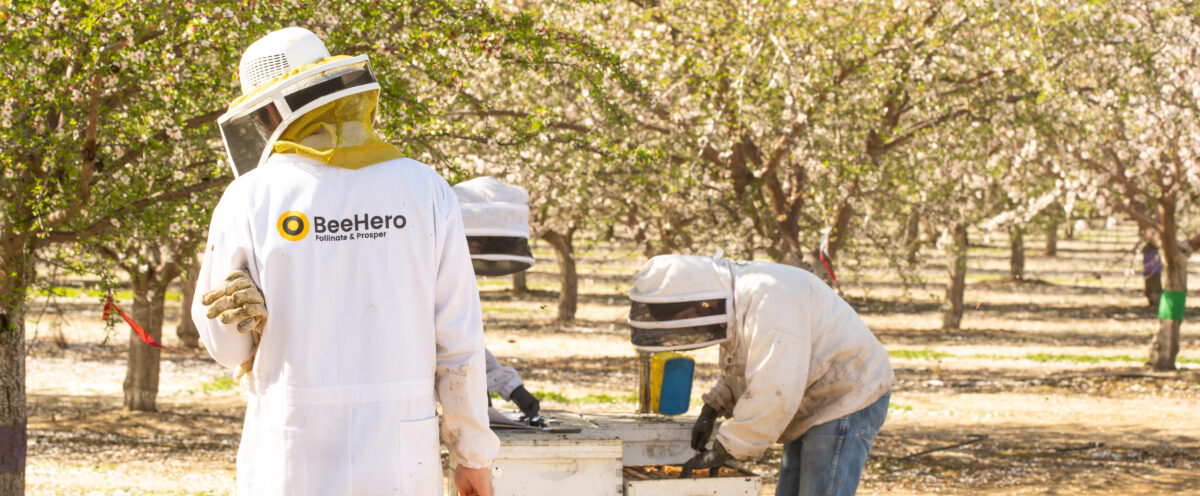
Photo contributed | BeeHero, a precision pollination company with offices in Fresno County, Israel and Australia, is using data analytics, AI and sensors to improve hive management and crop pollination.
Written by Frank Lopez
While agriculture spans diverse professions — from farmers and veterinarians to botanists and machine operators — one group plays a vital but often overlooked role: beekeepers.
Like other growers, beekeepers face increasing challenges: volatile weather, rising input costs, theft and widespread disease. Across the U.S. and in California, beekeepers are reporting significant die-offs among honeybee colonies.
Although Colony Collapse Disorder has been studied for decades, recent data show commercial beekeeping operations lost an average of 60% of colonies this spring alone. Since last summer, that represents 1.7 million bees lost and a $600 million financial hit.
A common thread in the failed hives: varroa mites, parasitic pests that spread disease and have grown resistant to many chemical treatments. These mites are compounding existing threats such as pesticide exposure, habitat loss and food scarcity.
A local perspective
Ben Edkins, a beekeeper originally from England, runs Sweet Beezus in Selma. The business offers bee removal services and sells honey, bee pollen, and beeswax products. His goods are sold in locations such as Maiden Voyage Coffee Roasters in Selma, Watson’s Organic Market in Visalia and Casa de Fruta in Hollister.
Edkins started his beekeeping journey in 2021 with a backyard hive. He now manages around 380 hives at peak season. He said the Central Valley’s unique fruit-growing ecosystem makes bees indispensable.
“We are farmers,” Edkins said. “Bees are our livestock as opposed to cows. Everyone is aware that people selectively breed for different purposes. We do the exact same thing with bees.”
Unlike some operations, Edkins has avoided collapse by allowing hives to complete full cycles — letting queens stop laying eggs and letting colonies shrink naturally. He also studies wild bees to adapt more resilient practices.
Despite these efforts, rising input costs — including electricity for honey extraction and storage, and glass jars — are squeezing margins.
Edkins also faces a troubling trend: beehive theft. Thieves, often experienced with bees, rebrand stolen hives and sell pollination services to farmers under false pretenses.
“The worst part is, it’s generally committed by someone who has experience with bees,” he said.
Even as operating costs rise, Edkins said it’s hard to raise honey prices. Consumer spending appears to be tightening.
“People are currently dropping off in buying with higher prices across the board,” he said.
Public awareness is another concern. Edkins said some people fail to understand bees’ critical role in agriculture.
“One bee could visit 1,000 flowers in a day. That 1,000 flowers could become 1,000 more apples,” he said. “When it comes to removals, we get people that tell us if we can’t remove the bees they’re going to kill them. It’s as if we are being blackmailed to get the bees out of someone’s house.”
He’s also seen a drop in removal calls, likely due to winter colony collapses.
BeeHero’s AI approach
BeeHero, a precision pollination company with offices in Fresno County, Israel and Australia, is using data analytics, AI and sensors to improve hive management and crop pollination.
CEO Omer Davidi said their tools help beekeepers monitor hive health and navigate environmental stressors. Australia, once free of varroa mites, has recently seen outbreaks.
“Getting more visibility into the hives and helping beekeepers handle the changing environment is critical,” Davidi said. “In certain areas in Australia, pollination was provided by wild insects — that’s going to shift.”
Davidi noted that mites affect both managed and wild bee populations, forcing farmers and beekeepers to rethink pollination strategies. Beekeepers have struggled with colony collapse for over 15 years, but the 60% loss this year has some questioning whether this is a one-off event — or the new norm.
“There are not a lot of profit margins to support a 60% loss,” Davidi said.
He emphasized that solving the crisis will require collaboration among scientists, companies, and farmers. Strategies include breeding more resilient bee colonies and deploying new mite treatments that don’t harm bees.
The California almond industry, which contributes an estimated $11 billion in economic added value, is wholly dependent on bees for pollination services. The fate of the industry is tied to bees.
“Certain beekeepers are very hesitant to send bees from other areas to California because there is a lot of diseases in the area,” Davidi said. “We are seeing beekeepers charge higher prices to keep their head above water, but it’s still too early to say if it’s going to be a long-term thing or a one-year thing.”








